The 10 Best Ennio Morricone Movie Soundtracks
Ennio Morricone is an undisputed phenomenon in the field of film music. The Italian artist created soundtracks for more than 500 pictures, working with the greatest directors, such as Pierro Paolo Passolini, Bernardo Bertolucci and Brian De Palma. Above all, Morricone’s unique artistic duet with Sergio Leone, the creator of spaghetti westerns, has gone down in cinema history. The composer was also loved by Hollywood, and in 2007 he was honored with an Oscar for his magnificent work. The statuette was presented to him (how could it not be) by Clint Eastwood, the star of Leone’s films. Here is a selection of 10 films with the Master’s music.
The best movies with music by Ennio Morricone
1.”Dollars Trilogy”, dir. Sergio Leone, 1964-66
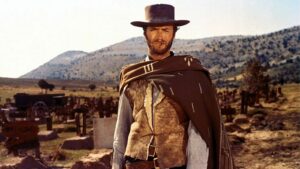
Dollars Trilogy is a cult series of spaghetti westerns by Sergio Leone, consisting of: “A Fistful of Dollars” (1964), “For a Few Dollars More” (1965) and “The Good, the Bad and the Ugly” (1966). The central figure of these films is dressed in a distinctive poncho and smoking a cigar, a nameless gunman played by Clint Eastwood.
It was thanks to the Dollar Trilogy that the world audience discovered the talent of the Italian composer. Ennio Morricone perfectly conveyed the villainous and aggressive character of the individual westerns by means of dynamic, simple to hum melodies played on such musical instruments as the drum, flute, electric guitar and trumpet, and enriched by sound effects – the ringing of bells, the smack of a whip, human whistling or the howling of a coyote.
2. “Once Upon a Time in America”, dir. by Sergio Leone, 1984
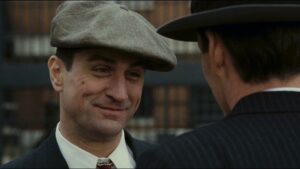
This is one of the flagship works of Ennio Morricone’s career and by far the most important achievement of the master from the 1980s, summing up his long collaboration with Sergio Leone. “Once Upon a Time in America” tells the story of several New York gangsters of Jewish descent, linked since childhood by bonds of friendship and difficult experiences. The main roles are played here by Robert De Niro a James Woods. Noodles’ great love, Deborah, meanwhile, was played by Elizabeth McGovern
Morricone’s music perfectly captures, or rather co-creates, the atmosphere of the time and place of the events. It builds the atmosphere of New York in the 1920s and 1930s, captures the nostalgia of the protagonist recalling his life after 30 years, and the individual motifs of the plot. Particularly memorable is the dramatic scene of little Dominic’s death on the Brooklyn Bridge, the tragedy of which is emphasized by the slow motion and, of course, Morricone’s music.
3. “The Mission”, directed by Roland Joffé, 1986
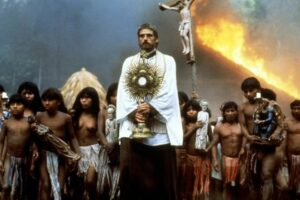
The Palme d’Or-winning moving film about the erasure of guilt and spiritual rebirth. The thing takes place in the 18th century in South America. Jesuit Father Gabriel (Jeremy Irons) undertakes an expedition deep into the jungle on a mission to spread faith in Jesus Christ among the Indians of the Guarani tribe. Along with him “up the waterfalls” wanders former slave trader and fratricide, Rodrigo Mendoza (Robert De Niro), who carries heavy armor and a sword for penance. The Jesuits’ successful missionary work in the Indian village is shattered by the acquisition of the Spanish colony by the Portuguese….
The soundtrack to “The Mission” is one of the greatest achievements of Ennio Morricone, who himself called his work “a true miracle” and was nominated for an Oscar for it. Interestingly, when the maestro first watched the Mission still in the non-sound version, he stated that the picture was so beautiful that a musical illustration by him could destroy it and… capitulated!
It should be added that the music in “The Mission” is not only a delightful heavenly sounds and choir singing background for the unfolding action, but also an important element of the plot. The scene in which Father Gabriel plays the oboe and thus fends off an attack by the Indians, who are initially hostile to him, convinces us that music can prove to be a useful medium on the road to integrating different nationalities, faiths and cultures.
4. “The Hateful Eight”, 2015
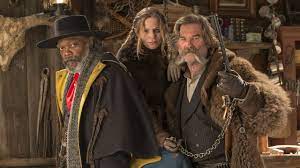
The soundtrack to Quentin Tarantino’s “The Hateful Eight” is Ennio Morricone’s only Oscar-winning individual work. The action of the picture, which is maintained in the convention of westerns, takes place during a cold winter in Wyoming, a few years after the Civil War. John Ruth (Kurt Russell), a famous headhunter, escorts a dangerous criminal, a certain Daisy Domergue (Jennifer Jason Leigh), to prison. On the way they meet another villain tracker, Major Marquis Warren (Samuel L. Jackson), and together they spend the night in a cut-off inn. It will be a night full of unexpected twists and turns….
Morricone, as a master of the Western musical convention (he returned to it after more than 40 years), with the sounds of whistles, revolver gunshots and the indispensable mouth harmonica, has excelled as a composer for Tarantino’s film. His music oscillates between traditional convention and ironic modern commentary and pastiche, conveying a whole range of changing moods.
5. “Cinema Paradiso” (“Nuovo cinema Paradiso”), dir. by Giuseppe Tornatore, 1988
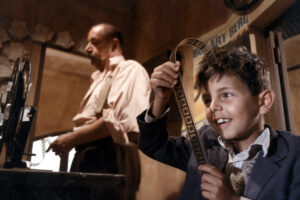
“Cinema Paradiso” is Giuseppe Tornatore’s love letter to the X muse. The film is a nostalgic story about a certain old cinema in the Italian town of Giancaldo. The main character, a boy named Toto (Salvatore Cascio), befriends the cinematographer who works there, Alfredo (Philippe Noiret). Fascinated by the magic of moving pictures, Toto becomes a famous film director (Jacques Perrin) years later.
“Cinema Paradiso” was the project that initiated a long and harmonious collaboration between Morricone and Tornatore. As the composer justified his participation in this production: “Presenting the history of cinema on the screen through kissing scenes censored by a local priest seemed to me a brilliant idea […]. And I immediately developed the Cinema Paradiso theme.” It is interesting to note that some of the melodic lines for the film, including the famous Love Theme, were composed by the maestro’s son, Andrea Morricone.
6. “Once upon a Time in the West” (“C’era una volta il West”), 1968

An iconic entry in the oeuvre of the duo of Sergio Leone and Ennio Morricone. “Once Upon a Time in the West” is one of the most important spaghetti westerns, reevaluating the genre’s premise. The convention was born out of a desire to confront the myth of the Wild West, while being inspired by samurai cinema. Unlike traditional westerns, there is no clear division between good and evil, and the issue of relations with Indians disappears, while the Hispanic population living in the Mexican territories appears instead.
When a young wife becomes a widow as a result of a crime committed by a gang of ruthless Frank (Henry Fonda), Harmony decides to help her. In addition to Fonda, the film starred Charles Bronson and Claudia Cardinale. The key musical motif – the sound of the harmonica, repeated in the visual layer (prop and and nickname of the protagonist) – co-creates the meaning of the film. It weaves together elements of mystery from the past, revenge and pain.
7. “The Legend of 1900” (La leggenda del pianista sull’oceano, dir. Giuseppe Tornatore, 1998)
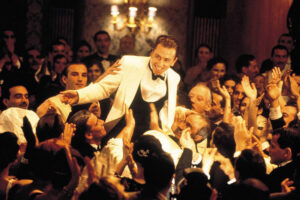
A fairy tale about a man who “did not exist for the world.” He was born and left alone on January 1, 1900 aboard an exclusive passenger ship traveling between Europe and the United States. Found and raised by an employee of the ship’s boiler room (Bill Nunn), “One Thousand Nine Hundred” (Tim Roth), as the crew members call the main character, turns out to be a brilliant pianist. His legend reaches land, but the man can’t give up life on the open ocean waters even in the name of love….
Creating a soundtrack for the film “The Legend of 1900” would be a tough nut to crack for any composer. “I was supposed to write ‘music that no one had ever heard,'” Peppuccio [Giuseppe Tornatore] used to say, describing it in the words of Alessandro Baricco, author of the story on which the film was based. Undoubtedly a beautiful phrase… but what if you are the one to compose such a melody?” – mentioned in his autobiography Ennio Morricone. Fortunately, the director entrusted this mission to the right hands, as best evidenced by the scene of a musical duel between the protagonist and the legendary black jazz pianist Jelly Roll Morton (Clarence Williams III). “It’s the pinnacle of virtuosity performed by the wonderful Gilda Buttà,” Morricone said of the piece through which One Thousand Nine Hundred defeats its opponent. “We superimposed selected passages in the recording to get the sound of several pianos in one, and Peppuccia’s efficient editing produced a convincing effect.”
8. “Frantic”, dir. Roman Polanski, 1988
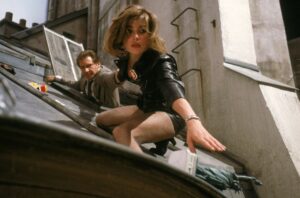
The impressive fruit of Ennio Morricone’s collaboration with Roman Polanski. “Frantic”, which is the extremely dark story of an American whose charming trip to France ends in drama. His wife is kidnapped, and he, unable to count on the help of helpless police, on his own tries to unravel the mystery of her disappearance. He is aided in his search by a beautiful French woman, Michele. Starring Harrison Ford and Emmanuelle Seigner in the lead roles.
In addition to the adapted music, i.e. Grace Jones’ highly atmospheric song “I’ve Seen that Face Before,” Morricone’s magnetizing soundtrack is memorable. It is it that completes the whole work, giving it a specific French atmosphere – a nocturnal Paris full of secrets. This is particularly reflected in the final sequences, when percussion is replaced by accordion and piano, moving from the universal musical layer to typically French sounds.
9. “The Octopus” series (“La piovra”, 1984)
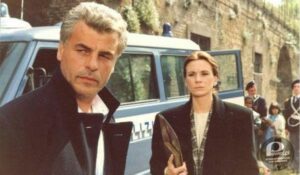
An item perhaps not the most famous, but certainly worth watching, especially because of Ennio Morricone’s wonderful music. The 1984 Italian serial is the story of Inspector Corrado Cattani, who arrives with his family in Sicily, where he takes over after the murdered head of the crime department. His task is to unravel the crimes of the local mafia. It soon becomes clear that the biggest price for the uncompromising attitude of the policeman will be paid by his family. The main role in “Octopus” was played by Michele Placido. The main musical theme from the series is a beautiful nostalgic melody that harmonizes with the phenomenal Sicilian landscapes and contrasts with the brutality of the ruthless mafia. It is dominated by moving lyrical and mournful tones, deeply memorable
10. “Karol – A Man Who Became Pope” (Karol, un uomo diventato Papa and Karol, un Papa rimasto uomo, dir. Giacomo Battiato, 2005-2006)
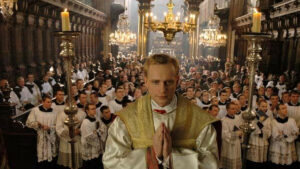
“Karol – A Man Who Became Pope” (2005) and “Karol – The Pope, The Man” (2006) are international productions about John Paul II, played by Piotr Adamczyk. The first part is about the uneventful life of Karol Wojtyla until he was elected head of the Roman Catholic Church. The second – shows the years of his extraordinary pontificate.
The soundtrack to the films about the Polish pope reveals Ennio Morricone’s special love for mystical music, which germinated in him while he was studying at the St. Cecilia Academy of Music in Rome. As the maestro recounted: “I studied Gregorian chant with genuine enthusiasm, and years later came to the conclusion that it played a key role not only in our history [of Western culture], but also in my personal history as a composer. It is possible that this is where my interest in religious singing and, consequently, sacred music originated.”
The ranking was prepared by: Kinga Redlinska and Agnieszka Czarkowska-Krupa
Share “10 most famous films with Ennio Morricone’s works” with your friends.
